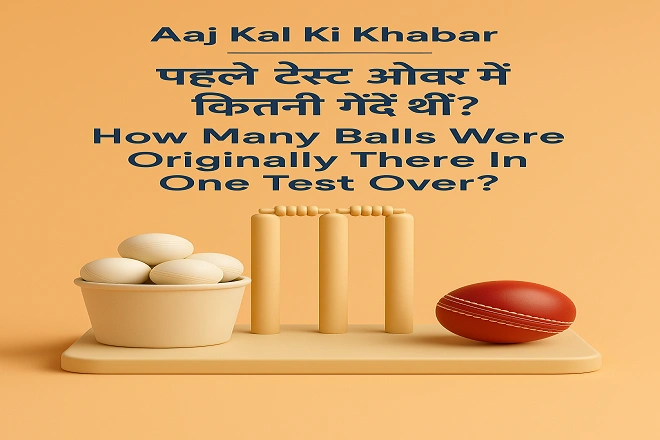“Aaj Kal Ki Khabar” is a bilingual website that delivers useful and interesting information related to health, spirituality, and lifestyle. The platform presents content in a simple and easy-to-understand language, offering insights that are helpful in everyday life.
How Many Balls Were Originally There In One Test Over? , You’re standing on the boundary of a vintage cricket ground. White-clad players are locked in battle, the bowler takes a long run-up, and the umpire raises his hand to signal the end of the over. Today, we all know that a standard over in cricket consists of six balls. But has it always been this way?
The surprising answer is—no. The number of balls in a Test match over has changed over time. So let’s go back in time and unravel this fascinating part of cricket history. From 4-ball overs to 8-ball experiments, get ready for a journey that will make you look at every over a little differently.
Table of Contents
ToggleThe Early Days of Test Cricket
Test cricket began in 1877, with the first official match between England and Australia. Back then, the game looked very different—no helmets, uncovered pitches, and even the rules were still evolving. One of the most interesting rules? An over consisted of only 4 balls in the early days!
How Many Balls Were Originally There In One Test Over? A Timeline of Changes
Over time, the number of balls in an over changed several times depending on the country and the era.
| Period | Balls Per Over | Where Applied |
|---|---|---|
| 1877 – 1889 | 4 balls | England, Australia |
| 1889 – 1899 | 5 balls | Australia |
| 1900 – 1922 | 6 balls | England, South Africa |
| 1922 – 1936 | 8 balls | Australia, New Zealand |
| 1936 – 1979 | 6 or 8 balls | Varies by country |
| 1979 – Present | 6 balls | Standard worldwide |
Why Did the Number of Balls Change?
There were many reasons for changing the number of balls per over:
-
Experimentation: In the early years, cricket was still finding its best format.
-
Bowler workload: Longer overs could be tiring, while shorter ones didn’t allow rhythm.
-
Pace of play: Organizers wanted a balance between bat and ball.
-
Audience engagement: With growing audiences (especially via radio and TV), consistency helped viewership.
Country-Specific Rules and Variations
Different countries adopted different over lengths based on their cricketing needs:
-
Australia: Used 8-ball overs in Test matches from 1924 to 1979.
-
New Zealand: Also adopted 8-ball overs during this time.
-
India and England: Shifted to 6-ball overs early and maintained the format.
A Quick Timeline of Over Changes
| Year | Change |
|---|---|
| 1877 | First official Test—4-ball overs |
| 1889 | Australia switches to 5-ball overs |
| 1900 | England and SA adopt 6-ball overs |
| 1924 | Australia adopts 8-ball overs |
| 1979 | ICC standardizes 6-ball overs |
Why 6 Balls Became the Standard
Today, 6 balls per over is the global standard—but why?
-
Time management: Keeps the game’s pace consistent.
-
Bowler balance: Less tiring than 8-ball overs, more engaging than 4.
-
Broadcasting: Suits commercial breaks and scheduling.
-
Uniformity: A consistent rule across all cricket-playing nations is easier for players and fans.
Could This Change Again in the Future?
It’s unlikely that Test cricket will change its over length again soon. However, in newer formats like The Hundred (played in England), bowlers deliver 5 or 10 consecutive balls instead of traditional overs—showing that cricket still evolves!
Conclusion: One Over, Many Stories
So, how many balls were originally there in a Test over? Just 4! Since then, cricket has experimented with 5, 6, and even 8-ball overs. Each shift tells a story of how the game adapted to its players, fans, and technology. The next time you watch a bowler finish their 6-ball over, remember—it wasn’t always that way. That little segment of the game carries over a century of change, logic, and tradition.
Frequently Asked Questions (FAQ)
How many balls were there in the first Test over?
The first official Test match in 1877 had 4-ball overs.
When did the 6-ball over become the standard?
Around 1900, England and South Africa began using 6-ball overs. It was formally standardized by the ICC in 1979.
Did any country use 8-ball overs?
Yes, Australia and New Zealand used 8-ball overs in Test matches, especially between 1924 and 1979.
Why was the number of balls in an over changed?
To find a balance between bowler fatigue, game pace, and audience engagement. Longer overs helped time efficiency; shorter ones helped bowler rhythm.
Can the number of balls in an over change again?
While it’s unlikely in Test cricket, modern formats like The Hundred are experimenting with different formats—such as 5 or 10 consecutive deliveries.
When did India adopt the 6-ball over?
India followed the global trend and adopted 6-ball overs early in its Test history. It has used 6-ball overs in international cricket since the early 20th century.
Read More : tiranga ko kisne design kiya tha
